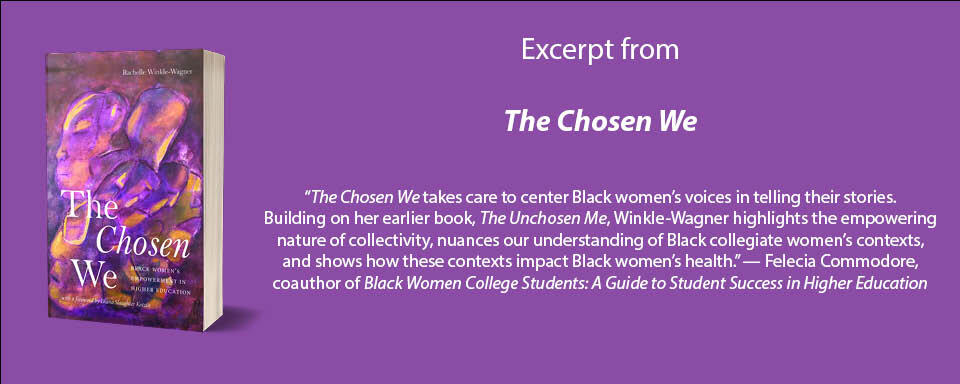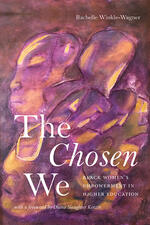
Excerpt: The Chosen We
The Chosen We: Black Women's Empowerment in Higher Education, by Rachelle Winkle-Wagner, draws on and centers oral histories with Black women college graduates to demonstrate the role of community in fostering their success in and beyond education.
"The Chosen We takes care to center Black women's voices in telling their stories. Building on her earlier book, The Unchosen Me, Winkle-Wagner highlights the empowering nature of collectivity, nuances our understanding of Black collegiate women's contexts, and shows how these contexts impact Black women's health." — Felecia Commodore, coauthor of Black Women College Students: A Guide to Student Success in Higher Education
The following is an excerpt from The Chosen We
“I Learned about People, and I Learned about My Degree”: Rita Mae’s Story
When Rita Mae greeted me at the door, I was struck by her gracefulness. Her beautiful home had a lovely mauve and teal color palette that was woven throughout every room. Even her carefully chosen casual Saturday attire alluded to her elegance. She matched from head to toe in colors that complemented her home. The grand piano in the hallway struck me right away and I confided to Rita Mae that I had been an undergraduate piano performance major but had stopped playing in recent years, a fact I shared with few people. She told me the piano was her husband’s and had been the root of his work as a classical musician. This provided us a space to connect with one another as we talked about our favorite piano pieces and about how difficult it is to have a career in music. As we drank tea, I learned that Rita Mae had attended predominantly White colleges and universities, in northeastern, midwestern, and southwestern states. My anxiousness melted away as I realized the project had never been and would never be about me; it was about the minute-by-minute possibility of building trust to allow peoples’ lives to emerge.
Rita Mae grew up in the South during the 1950s, at a time when schools were just starting to be forced to integrate racially, although admittedly many schools never really did integrate. Her primary and secondary schooling experience was in a neighborhood public school that was entirely Black. Her teachers and administrators had all earned at least a master’s degree. The assumption was that all students in her high school would attend college. In that segregated Black high school, the students were taught that they could be anything. She recounted:
There were 405 of us that graduated when I graduated, and five years later I think there were about 300 who had bachelor’s degrees, and when we did our thirtieth high school reunion, we did a little survey and we had PhDs, EdDs, MDs, law degrees, you name it. So those were the expectations that people had. You couldn’t teach in my high school unless you had at least a master’s degree. The principals had EdDs from Columbia University, Teachers College. That was one of the schools that allowed Black people [to attend], after they earned a bachelor’s and a master’s degree at a HBCU in the South. There were not a lot of PhDs or EdD programs in the South that had allowed people to get a doctorate. So, each summer, these people would go to Columbia, and they had places where they could stay and they may take one or two or three classes and it may have taken them 10 years but, they got their doctorate.
During the days of segregated education, Rita Mae’s high school was a good example of education that was created by and for Black people (Walker, 1996, 2000), a Chosen We amid a White supremacist and racist society (Kendi, 2016; Leonardo, 2013). Rita Mae attended segregated Black schools in the South that were likely underresourced, which was common when racial separation in education was legal in the United States (Walker, 1996, 2000, 2001).
Yet her teachers and administrators were highly educated, having earned bachelor’s degrees from historically Black colleges and universities (HBCUs) in the South during a time when higher education was also highly segregated (Smith, 2016; Walker, 2001). After having earned bachelor’s degrees, Rita Mae’s administrators and teachers often attended a highly prestigious Ivy League university, Columbia University, for their graduate-level degrees. While most higher education institutions were segregated during the 1950s and 1960s, some institutions, particularly Ivy League institutions like Columbia University, became well-known pathways to advanced degrees for African American people (Smith, 2016).
Rita Mae recounted her family’s participation in one of the major Black migration patterns (Wilkerson, 2011) from southern states to the northern states and cities on the West Coast that occurred from the time of Enslavement (before 1865) to the time of Reconstruction (1865–present). More than six million African American people left racial hostility to try to create more positive lives. Rita Mae explained, “Most people had friends and relatives in Alabama so New York, Harlem, was one of the places that people left my city to go to.” Referencing Black migration from southern states like Alabama to northern states like New York (Wilkerson, 2011), Rita Mae in her youth knew the pathway through higher education for Black people well. People would first attend an HBCU in the South, then migrate to northern states and stay with the generations of other Black people who had preceded them while earning a terminal degree from one of the precious few doctoral-granting institutions that admitted African American people at that time.
Racial segregation is a moral, economic, and social scar in the history of the United States that came directly out of the unconscionable and unforgivable enslavement of Black people. While school integration was meant to provide better resources and opportunities for Black people, it is important to note that many of its effects were quite negative due to the way that it was implemented (Walker, 1996, 2001). Black schools with Black teachers and administrators were teaching Black children in empowering, self-determined ways. Integration abandoned all of this for White teachers and administrators, who implemented White Eurocentric curriculums and pedagogies (Anderson, 1988; Walker, 1996, 2000, 2001; Watkins, 2001). It is not surprising, given the “White architects of Black education” as Watkins (2001) called them, that Black children left schools where their innate brilliance and possibility were honored, and entered schools in which they were seen and treated as deficient, inferior, and problematic. Rita Mae is a part of this history; she was on the cusp of this change. She had been educated in an all-Black school where her endless potential was assumed. It is not that integration was an obviously negative project. However, integration’s deliberate abandonment of empowering Black classrooms and schools was yet another example of racial reform efforts that may have never been intended to heal the racial inequality that founded the United States. Through the story of Rita Mae, and others like her, this book takes up the history of Black excellence and explores how it was collectively promoted across generations, with and without the support of White teachers, administrators, and educational systems.
After attending high school in Alabama, Rita Mae opted to leave the South to attend college at the University of New Haven in Connecticut. She also took courses at Connecticut State University. She had family in the Northeast with whom she could live. She graduated with a social sciences degree from New Haven in the 1960s. She earned a master’s degree at Michigan State University in a similar field in the 1980s. Rita Mae got married in her 30s and had children. Her graduate-level degree piqued her interest in more education, and she moved to Arizona where she earned a doctoral degree in a social sciences discipline in the 1990s at Northern Arizona University.
Rita Mae’s first year at the private, predominantly White, University of New Haven, which was founded as a branch of Yale University in the 1920s, ushered in a lot of new experiences and contacts with new people:
I think I learned about people and about my degree. It was an engineering college, an offshoot of Yale. It was predominately male, very few females, and they had a strong Business Department and a strong Social Science Department. I was a commuter student; I lived with my aunt, and she lived in a predominantly Italian community. The predominant students there [at UNH] were Italian, Irish, and Jewish. A lot of Jewish kids came from New York. I remember being in a predominantly White environment and among a lot of males; my passion for sociology came about.
Rita Mae used the new experience—being around mostly Irish, Italian, and Jewish students in college—a type of sociological study of her own. She drew upon the history of Whiteness in the United States where many groups, even those with fair complexions, were not considered “White” for a long time. In recent years, most people would simply refer to all these student populations as White. But at the time when Rita Mae was in college, Irish, Italian, and Jewish people were not necessarily considered White in the United States (Yancy, 2003). These groups, particularly Italian and Irish populations, eventually became “White” and were included as such in the census and other demographics (Lieberson, 1980; Yancy, 2003, 2016). When they initially came to this country, however, they were often “othered” and they were not given many of the economic and social privileges attached to Whiteness (Lieberson, 1980; Yancy, 2016). Jewish populations were also often not completely accepted as “White” in the United States (Brodkin, 1998; Goldstein, 2006). While Jewish people are not typically considered a visible minority group, meaning that they are not phenotypically (skin tone) different from many European American groups, during the 1960s, there were still remnants of anti-Semitism from World War II and the Holocaust, during which millions of Jewish people were brutally murdered in the name of ethnic cleansing (Brodkin, 1998; Goldstein, 2006).
Rita Mae continued: “I had a Chinese professor and there was a chapter in my sociology class, there was a chapter on a ‘Negro’ family, and he skipped the chapter. He didn’t do the chapter and I went to him, and I said, ‘Well why, why aren’t we having, why aren’t we going to do this chapter?’ He said, ‘Because you’re the only Negro in the class.’ ” Rita Mae’s professor, who was Asian American, decided that the chapter about the Black family would not be useful or important to study because there was only one Black student in the class. Rita Mae used the word “Negro” because that is likely the word that was used to describe the Black family in her textbook at the time, even though the term has been associated with the oppression and derogation of Black people (Smith, 1992). The United States Census Bureau continued to use the term “Negro” until 2013 (Brown, 2013). Rita Mae elaborated on what happened next:
For each class you’d have to write a paper and so what did I write my paper on? The “Negro” family. I took all of the sociology courses that were taught there. I learned a lot. Everything I wrote about was some aspect of Black sociology, of the Black family. I got to know all the Black sociologists and had a really good time learning about them. At that point I had probably gone through college and had never known what a Black sociologist was or whether or not there were any at all.
Rita Mae refused to accept the invisibility of Blackness that her professors imposed on her. She took every opportunity to elevate Black families and Black scholars, choosing to build Black intellectual thought up around her, even in a predominantly White space. This was all learning she did on her own in addition to what she was learning in her coursework—she supplemented the Eurocentric learning with Black sociologists and her own interest in Black families.
There were very few Black students on campus at the University of New Haven. Rita Mae lived with her aunt. On campus, Rita Mae found that she mostly became friends with Jewish students: “I knew about prejudice, but I really probably didn’t know the word racism until later on. I thought as a group, probably the students who were the friendliest were the Jewish students. So, I got the chance to visit them in New York, and most of their parents were merchants, owned factories and different things.” Rita Mae remarked that many of the Jewish friends she made in college became lifelong contacts for her. They still travel back to meet up for reunions.
After finishing her undergraduate degree, Rita Mae pursued graduate education. She started her master’s degree at Southern Connecticut State University and eventually transferred to Michigan State University because by that time she was married, and her husband was pursuing his own PhD in Michigan. She began her doctoral degree at the University of Tennessee, but because she had children by then and her husband’s career had taken off, it was more difficult for her to finish. She ended up waiting until she moved to Northern Arizona University a few years later to complete the degree.
During her doctoral program, Rita Mae took on a leadership role to build a stronger community of Black women around her than she initially encountered when she entered the program. She explained, “The one thing that I did when I was at Northern Arizona University is I had an African American Woman’s support group because African American women were the minority women there. The majority of women were Native Americans at the school, Native Americans, Hispanics, White.” Black women felt isolated at Northern Arizona because there were not many Black students at the institution. Rita Mae noticed this isolation and decided to build a Chosen We community for younger Black women on campus. Realizing that a similar community would have helped her own sense of belonging in education, Rita Mae decided to create community for subsequent generations of Black women. She recalled:
I met with them on a Sunday afternoon, and we talked about different things. Finding peace with yourself, getting a good education, and these men [the athletes] probably may not be lasting relationships even if you got to them, based upon their kind of lifestyle of an athlete. And then making sure they master their subjects and took care of themselves. “You don’t have to be married by the time you’re 21.” I used myself as an example. I didn’t get married until I was 31. I didn’t think bad about myself. It allowed me to do a lot of things, meet a lot of people, have a lot of experiences, understand a lot of things, think for myself and so forth. I led that.
Rita Mae saw her role in her doctoral program as a leader who could help build community for younger Black women on campus. She used her own life experiences as examples that younger women could follow. By focusing on the community she built, she also reinforced her own self-esteem and sense of self. Throughout this book, and consistent with Rita Mae’s oral history, is the story of the continuous renewal of Black women creating communities of greatness or identifying those that already existed. Often these spaces were initiated before integration and have been created in obvious and subtle ways on college campuses ever since. As the oral histories in this book emphasize, being part of Chosen We communities was a transformative experience for the women in this book, and one that has a great deal to teach us about not only Black women but racial history, redemption, and hope in the United States as well.


